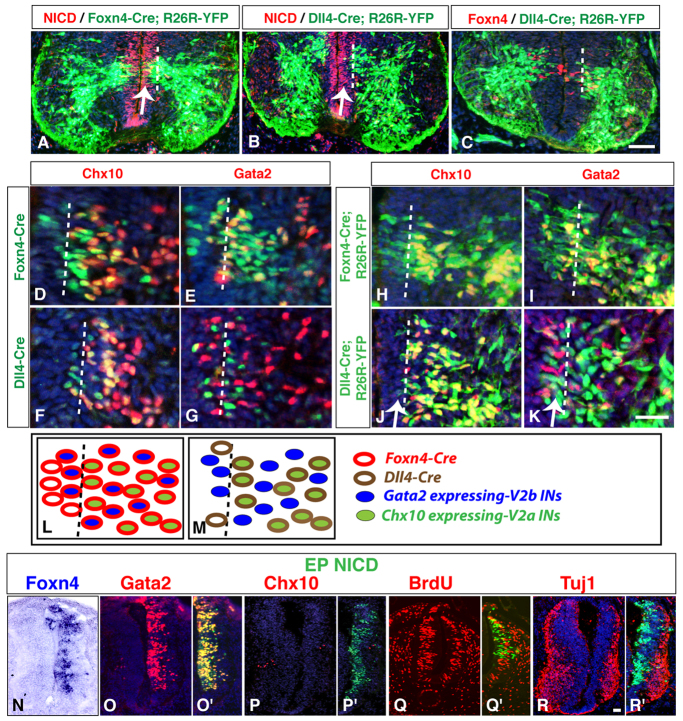Fig. 4.
Lineage tracing of Dll4-expressing precursors in the V2 domain. (A-C) In E11.5 Foxn4-Cre; R26R-YFP spinal cords, there was an extensive overlap of YFP with NICD in the progenitor domain (indicated by the arrow in A), whereas in Dll4-Cre; R26R-YFP spinal cords, there was hardly any overlap (indicated by the arrow in B). In addition, in Dll4-Cre; R26R-YFP spinal cords, Foxn4 immunostaining showed that YFP expression was initiated later than Foxn4 (C). (D,E) In E11.5 Foxn4-Cre spinal cords, there was an extensive overlap between Cre and Chx10 or Gata2 in V2 neurons. (F,G) In E11.5 Dll4-Cre spinal cords, Cre was co-expressed with Chx10, but excluded from Gata2 expressing cells. (H-K) In E11.5 Foxn4-Cre; R26R-YFP spinal cords, both Chx10- and Gata2-immunoreactive subtypes were immunoreactive for YFP. Similar tracing analysis with Dll4-Cre; R26R-YFP mice revealed extensive overlap between YFP and Chx10 expression (J) but showed a transient exclusion of YFP from Gata2-immunoreactive V2b precursors at early stages of differentiation (K, highlighted by the dashed line). (L,M) Schematic illustrating the Cre expression patterns in E11.5 Foxn4-Cre and Dll4-Cre spinal cords. Dotted vertical lines in A-M mark the transition zone between proliferating progenitors and differentiating neurons. (N-R′) Overexpression of activated Notch receptor (NICD) in the chick spinal cord caused widespread induction of Foxn4 and Gata2 expression (N-O′) but downregulation of Chx10 expression (P,P′). NICD-expressing cells hardly colocalized with those labeled by bromodeoxyuridine (BrdU) and failed to express Tuj1 (Q-R′). Scale bars: in C, 20 μm for A-C; in K, 12 μm for D-K; in R, 20 μm for N-R′.

